Leadership Report: Application of Skills, Theories, and Challenges
VerifiedAdded on 2023/01/18
|10
|3240
|1
Report
AI Summary
This report delves into the multifaceted aspects of leadership, exploring the author's personal leadership philosophy rooted in ethical principles and corporate social responsibility. It examines the application of leadership skills, particularly transactional and, at times, autocratic styles, and their impact on event management. The report evaluates the effectiveness of chosen leadership styles, proposing improvements such as incorporating diverse perspectives and fostering trust. It also addresses the motivation of co-workers through target setting, incentives, and support, as well as the handling of stress and conflicts within a team. Furthermore, it differentiates between formal and personal power, advocating for the latter to build trust and encourage employee dedication. Finally, the report acknowledges the challenges faced by leaders and suggests areas for improvement, emphasizing the importance of experience and adaptation in the evolving leadership landscape.
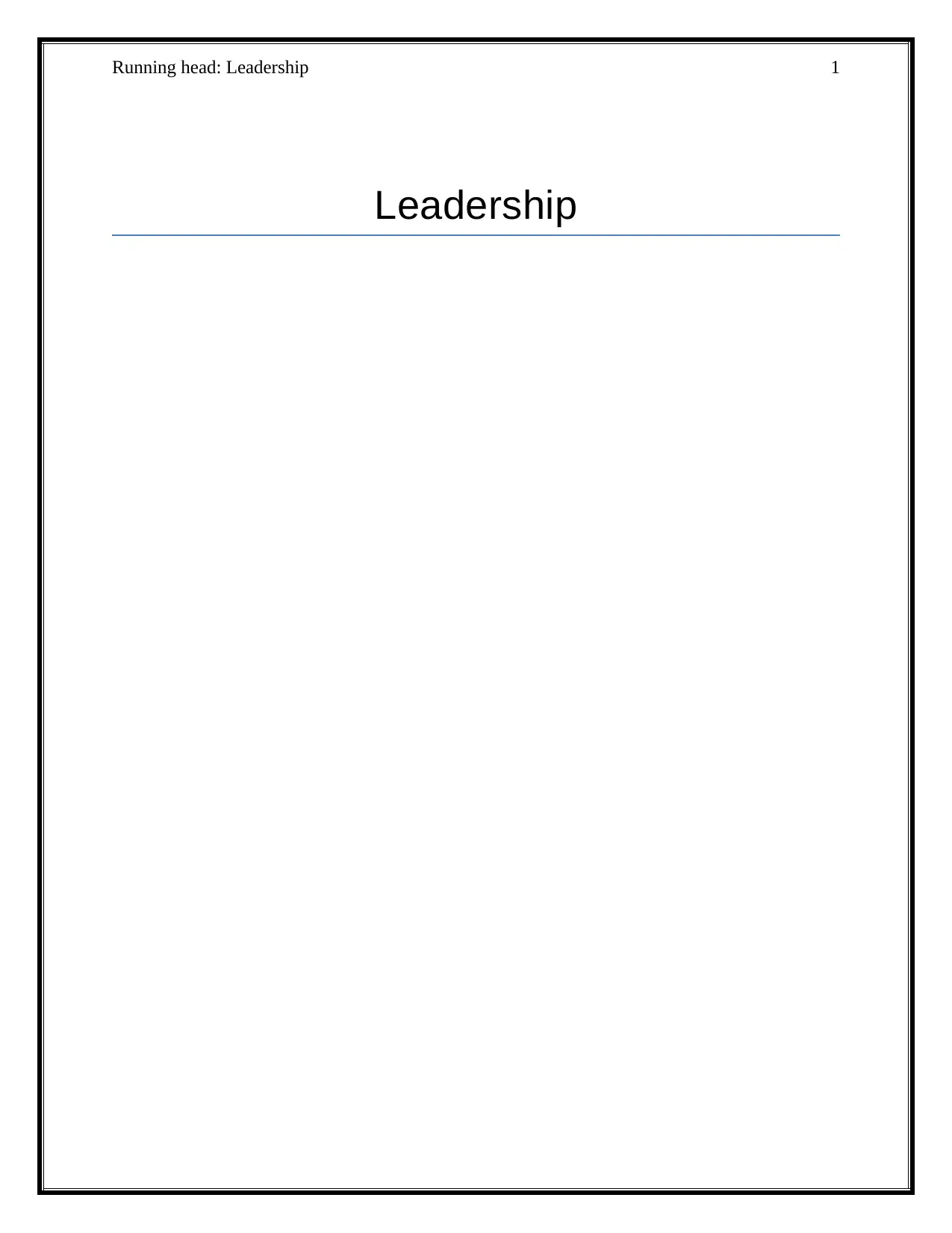
Running head: Leadership 1
Leadership
Leadership
Paraphrase This Document
Need a fresh take? Get an instant paraphrase of this document with our AI Paraphraser
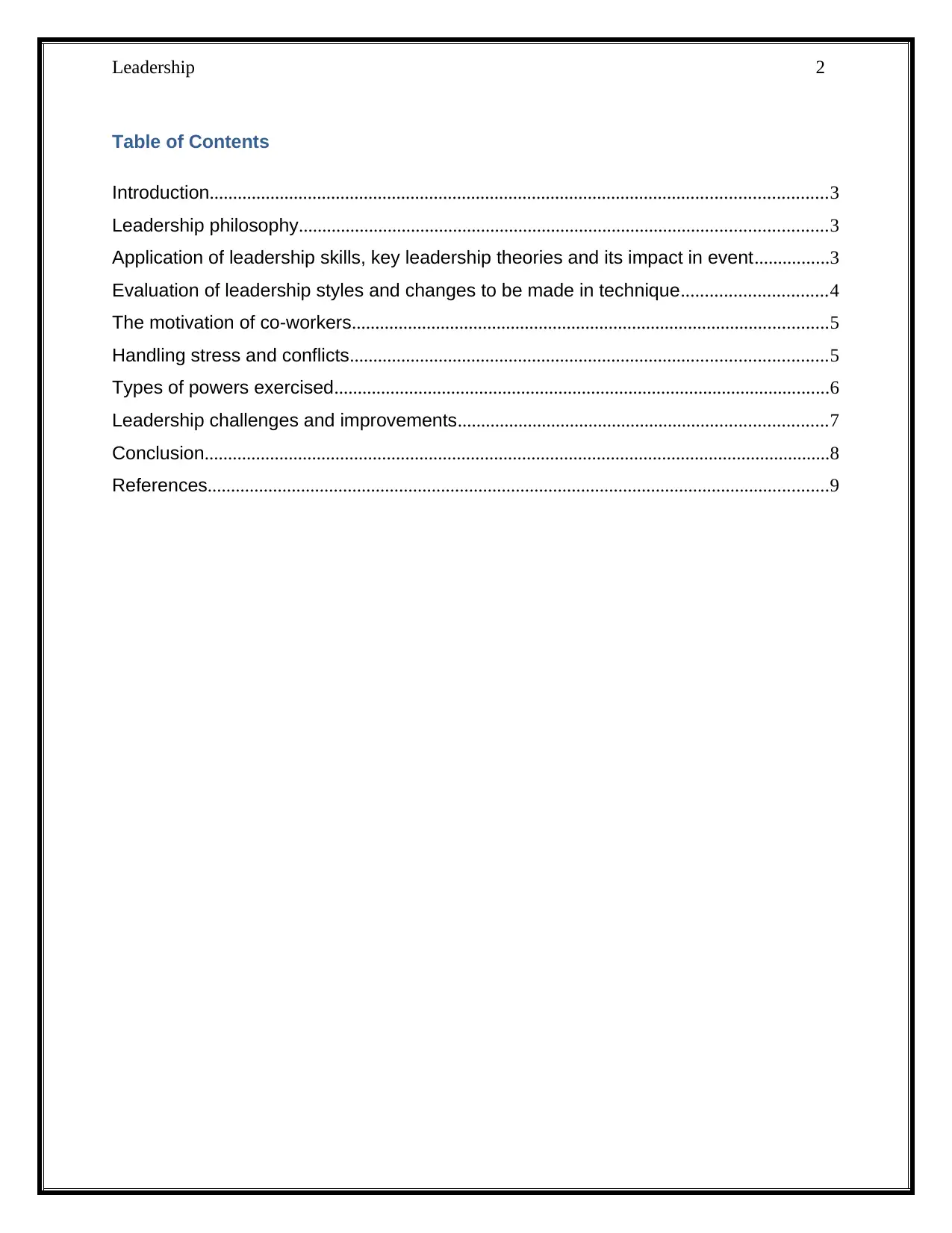
Leadership 2
Table of Contents
Introduction....................................................................................................................................3
Leadership philosophy.................................................................................................................3
Application of leadership skills, key leadership theories and its impact in event................3
Evaluation of leadership styles and changes to be made in technique...............................4
The motivation of co-workers......................................................................................................5
Handling stress and conflicts......................................................................................................5
Types of powers exercised..........................................................................................................6
Leadership challenges and improvements...............................................................................7
Conclusion......................................................................................................................................8
References.....................................................................................................................................9
Table of Contents
Introduction....................................................................................................................................3
Leadership philosophy.................................................................................................................3
Application of leadership skills, key leadership theories and its impact in event................3
Evaluation of leadership styles and changes to be made in technique...............................4
The motivation of co-workers......................................................................................................5
Handling stress and conflicts......................................................................................................5
Types of powers exercised..........................................................................................................6
Leadership challenges and improvements...............................................................................7
Conclusion......................................................................................................................................8
References.....................................................................................................................................9
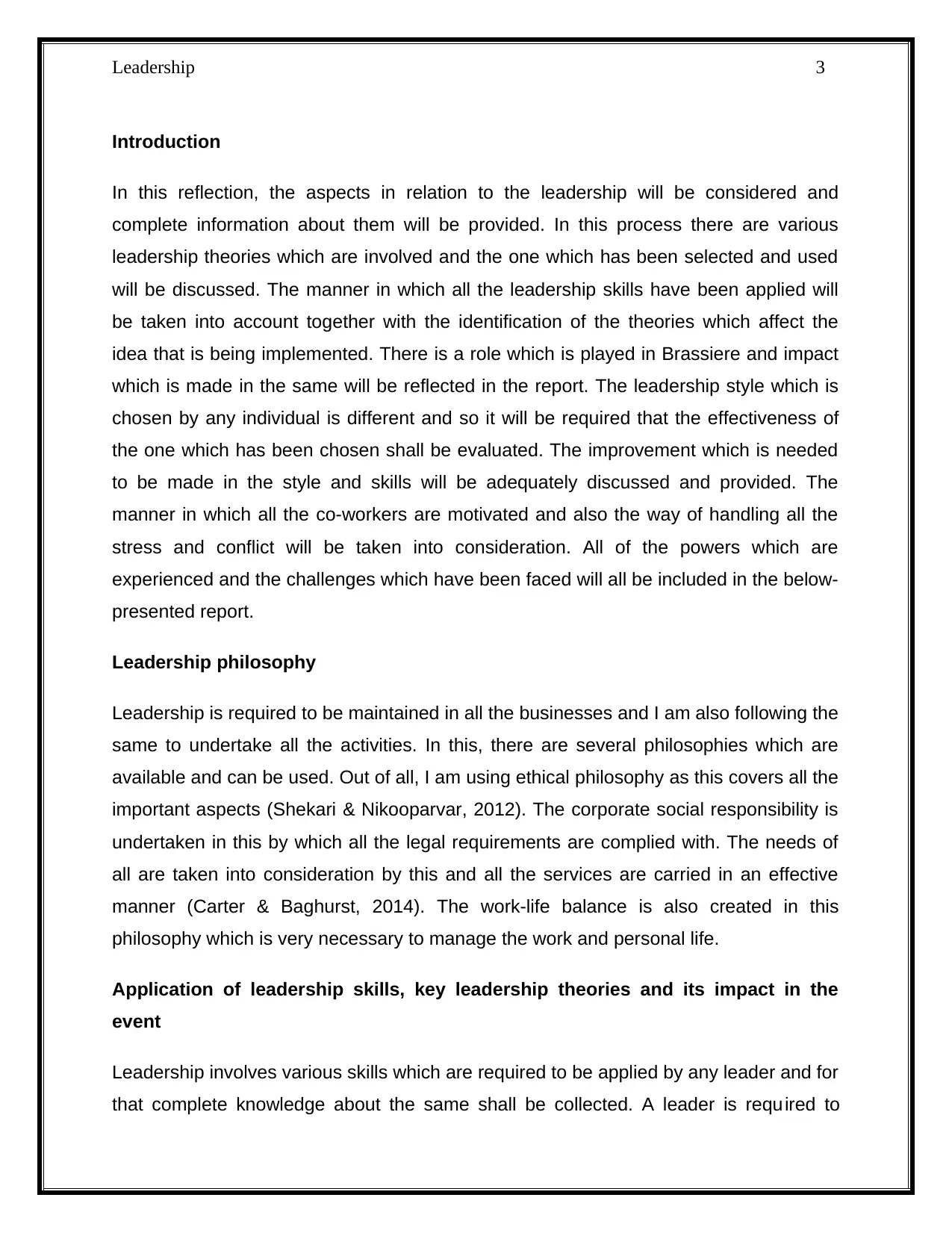
Leadership 3
Introduction
In this reflection, the aspects in relation to the leadership will be considered and
complete information about them will be provided. In this process there are various
leadership theories which are involved and the one which has been selected and used
will be discussed. The manner in which all the leadership skills have been applied will
be taken into account together with the identification of the theories which affect the
idea that is being implemented. There is a role which is played in Brassiere and impact
which is made in the same will be reflected in the report. The leadership style which is
chosen by any individual is different and so it will be required that the effectiveness of
the one which has been chosen shall be evaluated. The improvement which is needed
to be made in the style and skills will be adequately discussed and provided. The
manner in which all the co-workers are motivated and also the way of handling all the
stress and conflict will be taken into consideration. All of the powers which are
experienced and the challenges which have been faced will all be included in the below-
presented report.
Leadership philosophy
Leadership is required to be maintained in all the businesses and I am also following the
same to undertake all the activities. In this, there are several philosophies which are
available and can be used. Out of all, I am using ethical philosophy as this covers all the
important aspects (Shekari & Nikooparvar, 2012). The corporate social responsibility is
undertaken in this by which all the legal requirements are complied with. The needs of
all are taken into consideration by this and all the services are carried in an effective
manner (Carter & Baghurst, 2014). The work-life balance is also created in this
philosophy which is very necessary to manage the work and personal life.
Application of leadership skills, key leadership theories and its impact in the
event
Leadership involves various skills which are required to be applied by any leader and for
that complete knowledge about the same shall be collected. A leader is requ ired to
Introduction
In this reflection, the aspects in relation to the leadership will be considered and
complete information about them will be provided. In this process there are various
leadership theories which are involved and the one which has been selected and used
will be discussed. The manner in which all the leadership skills have been applied will
be taken into account together with the identification of the theories which affect the
idea that is being implemented. There is a role which is played in Brassiere and impact
which is made in the same will be reflected in the report. The leadership style which is
chosen by any individual is different and so it will be required that the effectiveness of
the one which has been chosen shall be evaluated. The improvement which is needed
to be made in the style and skills will be adequately discussed and provided. The
manner in which all the co-workers are motivated and also the way of handling all the
stress and conflict will be taken into consideration. All of the powers which are
experienced and the challenges which have been faced will all be included in the below-
presented report.
Leadership philosophy
Leadership is required to be maintained in all the businesses and I am also following the
same to undertake all the activities. In this, there are several philosophies which are
available and can be used. Out of all, I am using ethical philosophy as this covers all the
important aspects (Shekari & Nikooparvar, 2012). The corporate social responsibility is
undertaken in this by which all the legal requirements are complied with. The needs of
all are taken into consideration by this and all the services are carried in an effective
manner (Carter & Baghurst, 2014). The work-life balance is also created in this
philosophy which is very necessary to manage the work and personal life.
Application of leadership skills, key leadership theories and its impact in the
event
Leadership involves various skills which are required to be applied by any leader and for
that complete knowledge about the same shall be collected. A leader is requ ired to
⊘ This is a preview!⊘
Do you want full access?
Subscribe today to unlock all pages.

Trusted by 1+ million students worldwide
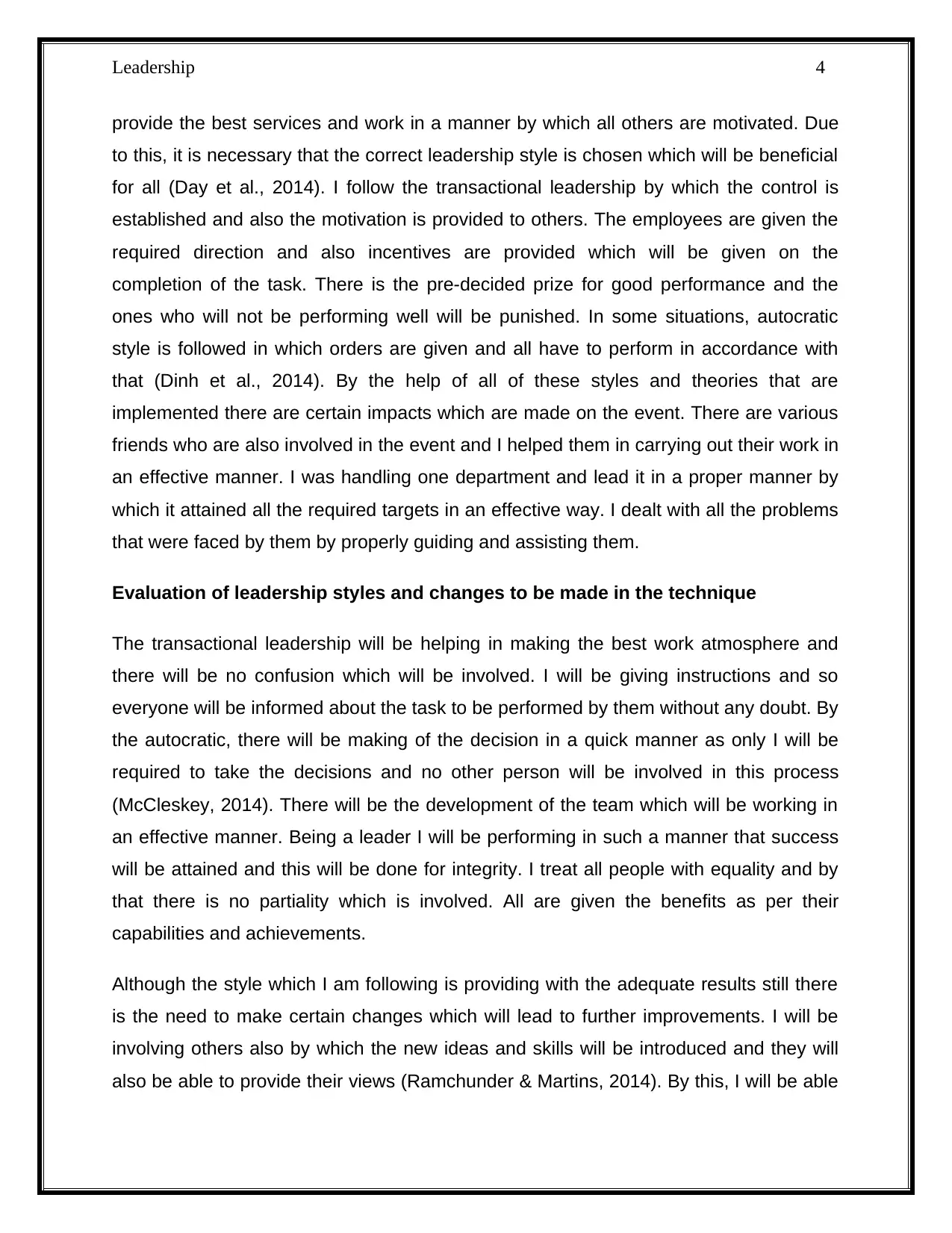
Leadership 4
provide the best services and work in a manner by which all others are motivated. Due
to this, it is necessary that the correct leadership style is chosen which will be beneficial
for all (Day et al., 2014). I follow the transactional leadership by which the control is
established and also the motivation is provided to others. The employees are given the
required direction and also incentives are provided which will be given on the
completion of the task. There is the pre-decided prize for good performance and the
ones who will not be performing well will be punished. In some situations, autocratic
style is followed in which orders are given and all have to perform in accordance with
that (Dinh et al., 2014). By the help of all of these styles and theories that are
implemented there are certain impacts which are made on the event. There are various
friends who are also involved in the event and I helped them in carrying out their work in
an effective manner. I was handling one department and lead it in a proper manner by
which it attained all the required targets in an effective way. I dealt with all the problems
that were faced by them by properly guiding and assisting them.
Evaluation of leadership styles and changes to be made in the technique
The transactional leadership will be helping in making the best work atmosphere and
there will be no confusion which will be involved. I will be giving instructions and so
everyone will be informed about the task to be performed by them without any doubt. By
the autocratic, there will be making of the decision in a quick manner as only I will be
required to take the decisions and no other person will be involved in this process
(McCleskey, 2014). There will be the development of the team which will be working in
an effective manner. Being a leader I will be performing in such a manner that success
will be attained and this will be done for integrity. I treat all people with equality and by
that there is no partiality which is involved. All are given the benefits as per their
capabilities and achievements.
Although the style which I am following is providing with the adequate results still there
is the need to make certain changes which will lead to further improvements. I will be
involving others also by which the new ideas and skills will be introduced and they will
also be able to provide their views (Ramchunder & Martins, 2014). By this, I will be able
provide the best services and work in a manner by which all others are motivated. Due
to this, it is necessary that the correct leadership style is chosen which will be beneficial
for all (Day et al., 2014). I follow the transactional leadership by which the control is
established and also the motivation is provided to others. The employees are given the
required direction and also incentives are provided which will be given on the
completion of the task. There is the pre-decided prize for good performance and the
ones who will not be performing well will be punished. In some situations, autocratic
style is followed in which orders are given and all have to perform in accordance with
that (Dinh et al., 2014). By the help of all of these styles and theories that are
implemented there are certain impacts which are made on the event. There are various
friends who are also involved in the event and I helped them in carrying out their work in
an effective manner. I was handling one department and lead it in a proper manner by
which it attained all the required targets in an effective way. I dealt with all the problems
that were faced by them by properly guiding and assisting them.
Evaluation of leadership styles and changes to be made in the technique
The transactional leadership will be helping in making the best work atmosphere and
there will be no confusion which will be involved. I will be giving instructions and so
everyone will be informed about the task to be performed by them without any doubt. By
the autocratic, there will be making of the decision in a quick manner as only I will be
required to take the decisions and no other person will be involved in this process
(McCleskey, 2014). There will be the development of the team which will be working in
an effective manner. Being a leader I will be performing in such a manner that success
will be attained and this will be done for integrity. I treat all people with equality and by
that there is no partiality which is involved. All are given the benefits as per their
capabilities and achievements.
Although the style which I am following is providing with the adequate results still there
is the need to make certain changes which will lead to further improvements. I will be
involving others also by which the new ideas and skills will be introduced and they will
also be able to provide their views (Ramchunder & Martins, 2014). By this, I will be able
Paraphrase This Document
Need a fresh take? Get an instant paraphrase of this document with our AI Paraphraser
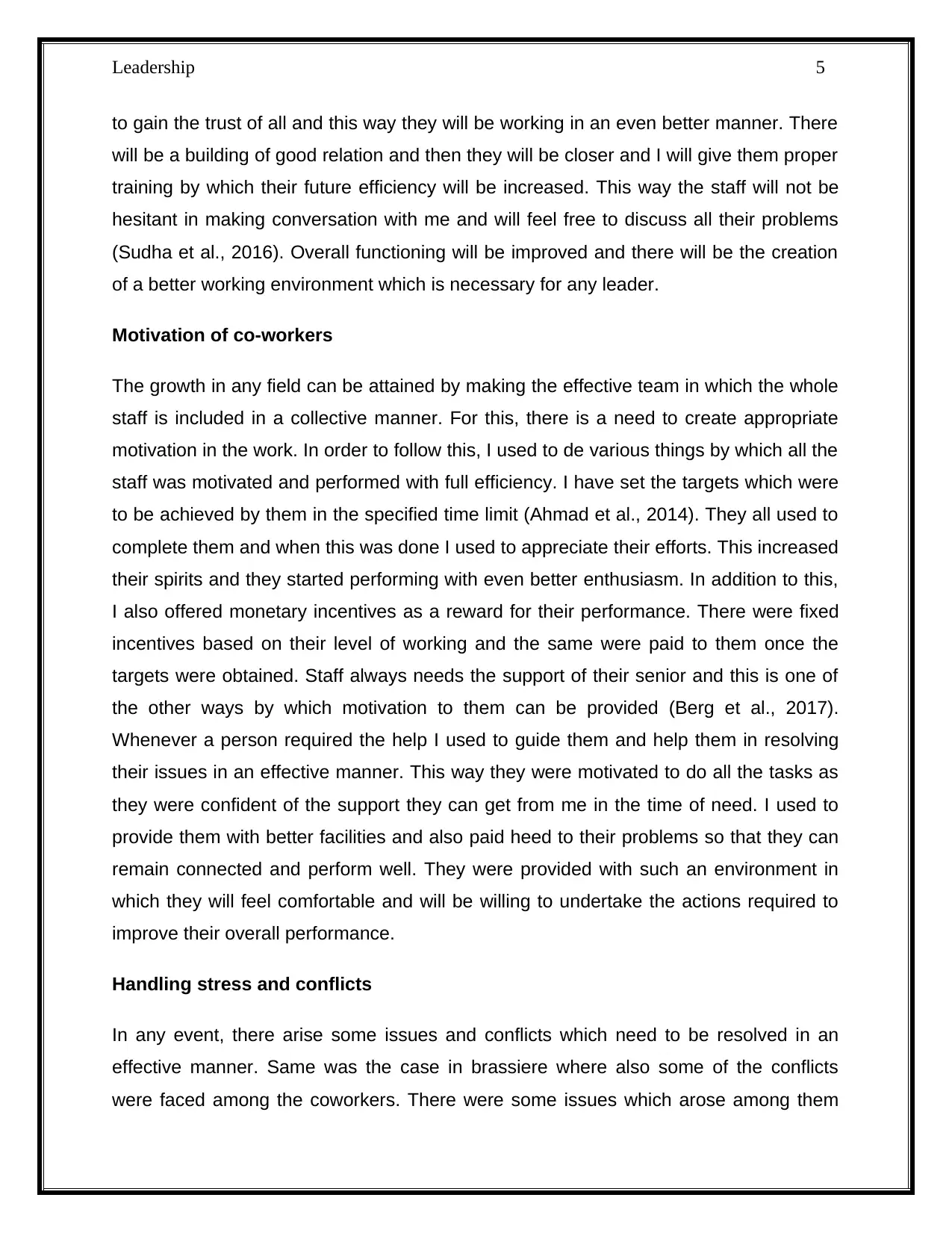
Leadership 5
to gain the trust of all and this way they will be working in an even better manner. There
will be a building of good relation and then they will be closer and I will give them proper
training by which their future efficiency will be increased. This way the staff will not be
hesitant in making conversation with me and will feel free to discuss all their problems
(Sudha et al., 2016). Overall functioning will be improved and there will be the creation
of a better working environment which is necessary for any leader.
Motivation of co-workers
The growth in any field can be attained by making the effective team in which the whole
staff is included in a collective manner. For this, there is a need to create appropriate
motivation in the work. In order to follow this, I used to de various things by which all the
staff was motivated and performed with full efficiency. I have set the targets which were
to be achieved by them in the specified time limit (Ahmad et al., 2014). They all used to
complete them and when this was done I used to appreciate their efforts. This increased
their spirits and they started performing with even better enthusiasm. In addition to this,
I also offered monetary incentives as a reward for their performance. There were fixed
incentives based on their level of working and the same were paid to them once the
targets were obtained. Staff always needs the support of their senior and this is one of
the other ways by which motivation to them can be provided (Berg et al., 2017).
Whenever a person required the help I used to guide them and help them in resolving
their issues in an effective manner. This way they were motivated to do all the tasks as
they were confident of the support they can get from me in the time of need. I used to
provide them with better facilities and also paid heed to their problems so that they can
remain connected and perform well. They were provided with such an environment in
which they will feel comfortable and will be willing to undertake the actions required to
improve their overall performance.
Handling stress and conflicts
In any event, there arise some issues and conflicts which need to be resolved in an
effective manner. Same was the case in brassiere where also some of the conflicts
were faced among the coworkers. There were some issues which arose among them
to gain the trust of all and this way they will be working in an even better manner. There
will be a building of good relation and then they will be closer and I will give them proper
training by which their future efficiency will be increased. This way the staff will not be
hesitant in making conversation with me and will feel free to discuss all their problems
(Sudha et al., 2016). Overall functioning will be improved and there will be the creation
of a better working environment which is necessary for any leader.
Motivation of co-workers
The growth in any field can be attained by making the effective team in which the whole
staff is included in a collective manner. For this, there is a need to create appropriate
motivation in the work. In order to follow this, I used to de various things by which all the
staff was motivated and performed with full efficiency. I have set the targets which were
to be achieved by them in the specified time limit (Ahmad et al., 2014). They all used to
complete them and when this was done I used to appreciate their efforts. This increased
their spirits and they started performing with even better enthusiasm. In addition to this,
I also offered monetary incentives as a reward for their performance. There were fixed
incentives based on their level of working and the same were paid to them once the
targets were obtained. Staff always needs the support of their senior and this is one of
the other ways by which motivation to them can be provided (Berg et al., 2017).
Whenever a person required the help I used to guide them and help them in resolving
their issues in an effective manner. This way they were motivated to do all the tasks as
they were confident of the support they can get from me in the time of need. I used to
provide them with better facilities and also paid heed to their problems so that they can
remain connected and perform well. They were provided with such an environment in
which they will feel comfortable and will be willing to undertake the actions required to
improve their overall performance.
Handling stress and conflicts
In any event, there arise some issues and conflicts which need to be resolved in an
effective manner. Same was the case in brassiere where also some of the conflicts
were faced among the coworkers. There were some issues which arose among them
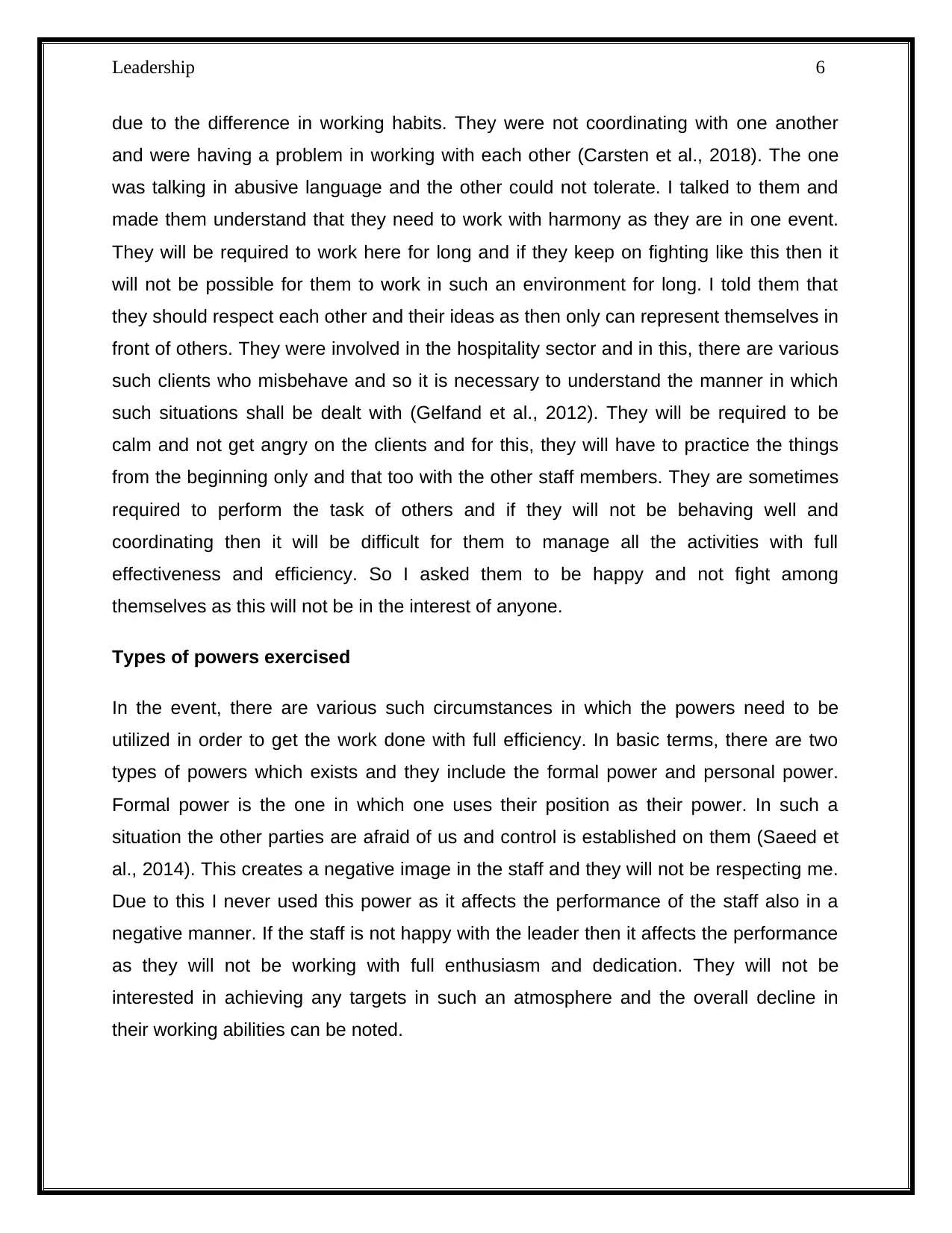
Leadership 6
due to the difference in working habits. They were not coordinating with one another
and were having a problem in working with each other (Carsten et al., 2018). The one
was talking in abusive language and the other could not tolerate. I talked to them and
made them understand that they need to work with harmony as they are in one event.
They will be required to work here for long and if they keep on fighting like this then it
will not be possible for them to work in such an environment for long. I told them that
they should respect each other and their ideas as then only can represent themselves in
front of others. They were involved in the hospitality sector and in this, there are various
such clients who misbehave and so it is necessary to understand the manner in which
such situations shall be dealt with (Gelfand et al., 2012). They will be required to be
calm and not get angry on the clients and for this, they will have to practice the things
from the beginning only and that too with the other staff members. They are sometimes
required to perform the task of others and if they will not be behaving well and
coordinating then it will be difficult for them to manage all the activities with full
effectiveness and efficiency. So I asked them to be happy and not fight among
themselves as this will not be in the interest of anyone.
Types of powers exercised
In the event, there are various such circumstances in which the powers need to be
utilized in order to get the work done with full efficiency. In basic terms, there are two
types of powers which exists and they include the formal power and personal power.
Formal power is the one in which one uses their position as their power. In such a
situation the other parties are afraid of us and control is established on them (Saeed et
al., 2014). This creates a negative image in the staff and they will not be respecting me.
Due to this I never used this power as it affects the performance of the staff also in a
negative manner. If the staff is not happy with the leader then it affects the performance
as they will not be working with full enthusiasm and dedication. They will not be
interested in achieving any targets in such an atmosphere and the overall decline in
their working abilities can be noted.
due to the difference in working habits. They were not coordinating with one another
and were having a problem in working with each other (Carsten et al., 2018). The one
was talking in abusive language and the other could not tolerate. I talked to them and
made them understand that they need to work with harmony as they are in one event.
They will be required to work here for long and if they keep on fighting like this then it
will not be possible for them to work in such an environment for long. I told them that
they should respect each other and their ideas as then only can represent themselves in
front of others. They were involved in the hospitality sector and in this, there are various
such clients who misbehave and so it is necessary to understand the manner in which
such situations shall be dealt with (Gelfand et al., 2012). They will be required to be
calm and not get angry on the clients and for this, they will have to practice the things
from the beginning only and that too with the other staff members. They are sometimes
required to perform the task of others and if they will not be behaving well and
coordinating then it will be difficult for them to manage all the activities with full
effectiveness and efficiency. So I asked them to be happy and not fight among
themselves as this will not be in the interest of anyone.
Types of powers exercised
In the event, there are various such circumstances in which the powers need to be
utilized in order to get the work done with full efficiency. In basic terms, there are two
types of powers which exists and they include the formal power and personal power.
Formal power is the one in which one uses their position as their power. In such a
situation the other parties are afraid of us and control is established on them (Saeed et
al., 2014). This creates a negative image in the staff and they will not be respecting me.
Due to this I never used this power as it affects the performance of the staff also in a
negative manner. If the staff is not happy with the leader then it affects the performance
as they will not be working with full enthusiasm and dedication. They will not be
interested in achieving any targets in such an atmosphere and the overall decline in
their working abilities can be noted.
⊘ This is a preview!⊘
Do you want full access?
Subscribe today to unlock all pages.

Trusted by 1+ million students worldwide
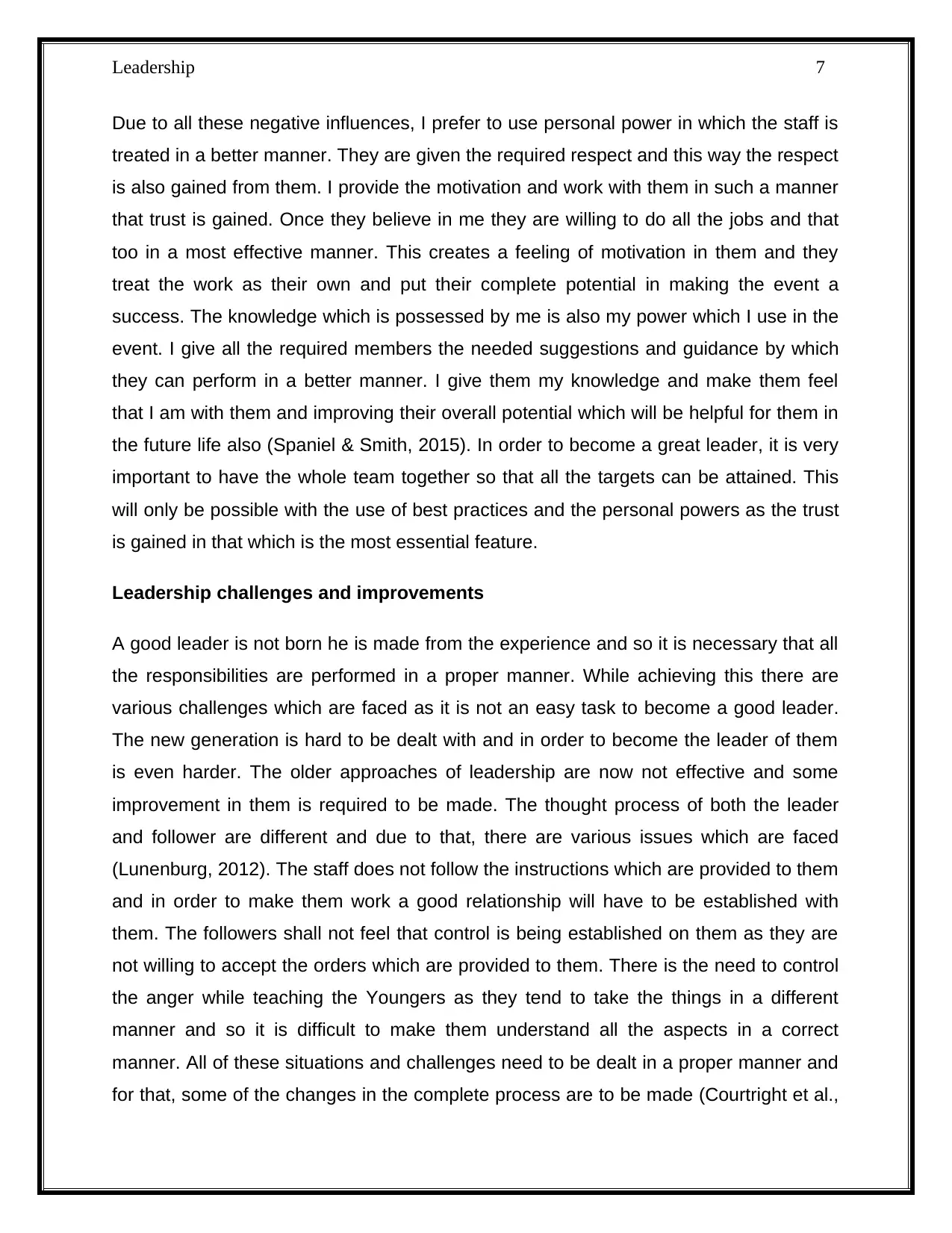
Leadership 7
Due to all these negative influences, I prefer to use personal power in which the staff is
treated in a better manner. They are given the required respect and this way the respect
is also gained from them. I provide the motivation and work with them in such a manner
that trust is gained. Once they believe in me they are willing to do all the jobs and that
too in a most effective manner. This creates a feeling of motivation in them and they
treat the work as their own and put their complete potential in making the event a
success. The knowledge which is possessed by me is also my power which I use in the
event. I give all the required members the needed suggestions and guidance by which
they can perform in a better manner. I give them my knowledge and make them feel
that I am with them and improving their overall potential which will be helpful for them in
the future life also (Spaniel & Smith, 2015). In order to become a great leader, it is very
important to have the whole team together so that all the targets can be attained. This
will only be possible with the use of best practices and the personal powers as the trust
is gained in that which is the most essential feature.
Leadership challenges and improvements
A good leader is not born he is made from the experience and so it is necessary that all
the responsibilities are performed in a proper manner. While achieving this there are
various challenges which are faced as it is not an easy task to become a good leader.
The new generation is hard to be dealt with and in order to become the leader of them
is even harder. The older approaches of leadership are now not effective and some
improvement in them is required to be made. The thought process of both the leader
and follower are different and due to that, there are various issues which are faced
(Lunenburg, 2012). The staff does not follow the instructions which are provided to them
and in order to make them work a good relationship will have to be established with
them. The followers shall not feel that control is being established on them as they are
not willing to accept the orders which are provided to them. There is the need to control
the anger while teaching the Youngers as they tend to take the things in a different
manner and so it is difficult to make them understand all the aspects in a correct
manner. All of these situations and challenges need to be dealt in a proper manner and
for that, some of the changes in the complete process are to be made (Courtright et al.,
Due to all these negative influences, I prefer to use personal power in which the staff is
treated in a better manner. They are given the required respect and this way the respect
is also gained from them. I provide the motivation and work with them in such a manner
that trust is gained. Once they believe in me they are willing to do all the jobs and that
too in a most effective manner. This creates a feeling of motivation in them and they
treat the work as their own and put their complete potential in making the event a
success. The knowledge which is possessed by me is also my power which I use in the
event. I give all the required members the needed suggestions and guidance by which
they can perform in a better manner. I give them my knowledge and make them feel
that I am with them and improving their overall potential which will be helpful for them in
the future life also (Spaniel & Smith, 2015). In order to become a great leader, it is very
important to have the whole team together so that all the targets can be attained. This
will only be possible with the use of best practices and the personal powers as the trust
is gained in that which is the most essential feature.
Leadership challenges and improvements
A good leader is not born he is made from the experience and so it is necessary that all
the responsibilities are performed in a proper manner. While achieving this there are
various challenges which are faced as it is not an easy task to become a good leader.
The new generation is hard to be dealt with and in order to become the leader of them
is even harder. The older approaches of leadership are now not effective and some
improvement in them is required to be made. The thought process of both the leader
and follower are different and due to that, there are various issues which are faced
(Lunenburg, 2012). The staff does not follow the instructions which are provided to them
and in order to make them work a good relationship will have to be established with
them. The followers shall not feel that control is being established on them as they are
not willing to accept the orders which are provided to them. There is the need to control
the anger while teaching the Youngers as they tend to take the things in a different
manner and so it is difficult to make them understand all the aspects in a correct
manner. All of these situations and challenges need to be dealt in a proper manner and
for that, some of the changes in the complete process are to be made (Courtright et al.,
Paraphrase This Document
Need a fresh take? Get an instant paraphrase of this document with our AI Paraphraser
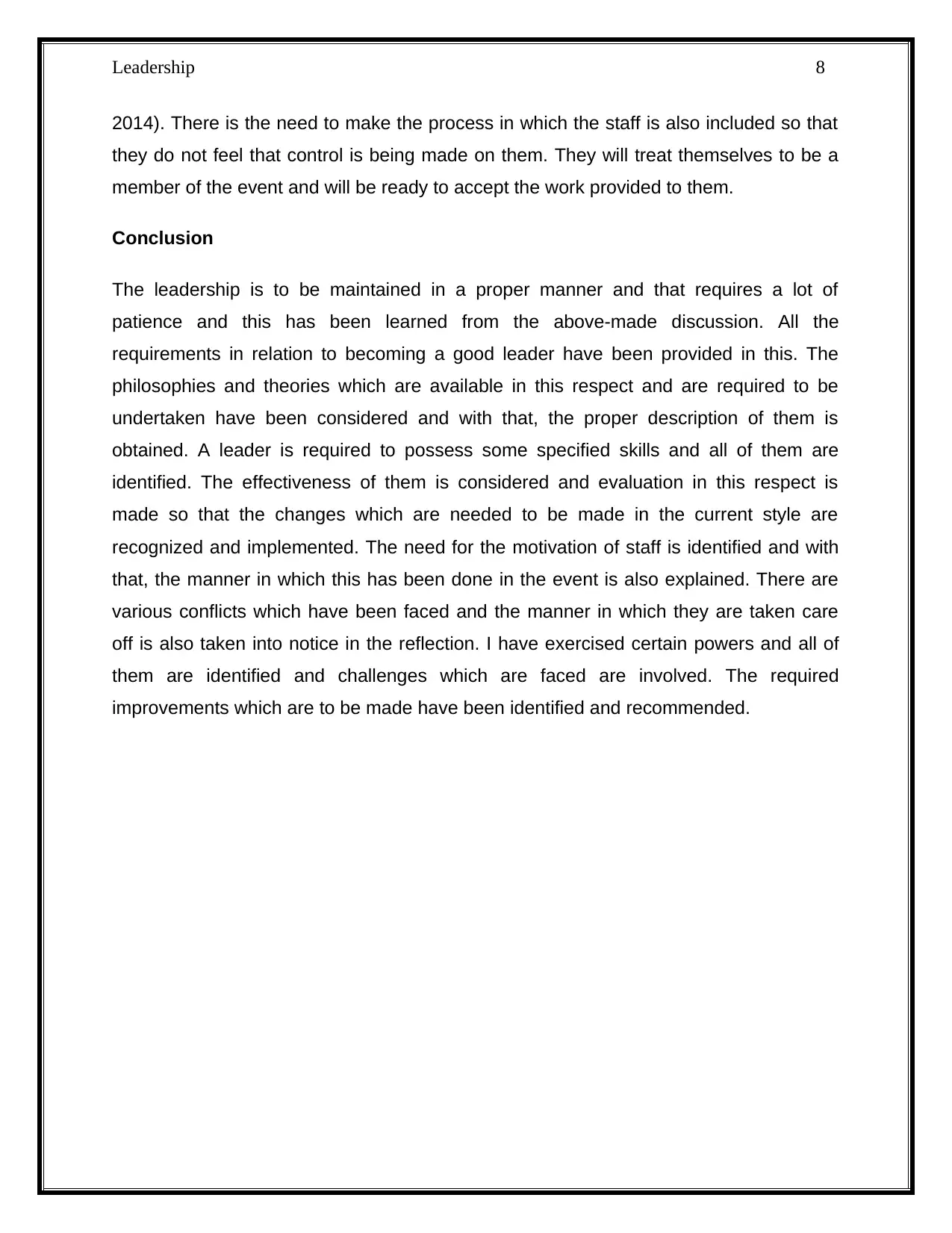
Leadership 8
2014). There is the need to make the process in which the staff is also included so that
they do not feel that control is being made on them. They will treat themselves to be a
member of the event and will be ready to accept the work provided to them.
Conclusion
The leadership is to be maintained in a proper manner and that requires a lot of
patience and this has been learned from the above-made discussion. All the
requirements in relation to becoming a good leader have been provided in this. The
philosophies and theories which are available in this respect and are required to be
undertaken have been considered and with that, the proper description of them is
obtained. A leader is required to possess some specified skills and all of them are
identified. The effectiveness of them is considered and evaluation in this respect is
made so that the changes which are needed to be made in the current style are
recognized and implemented. The need for the motivation of staff is identified and with
that, the manner in which this has been done in the event is also explained. There are
various conflicts which have been faced and the manner in which they are taken care
off is also taken into notice in the reflection. I have exercised certain powers and all of
them are identified and challenges which are faced are involved. The required
improvements which are to be made have been identified and recommended.
2014). There is the need to make the process in which the staff is also included so that
they do not feel that control is being made on them. They will treat themselves to be a
member of the event and will be ready to accept the work provided to them.
Conclusion
The leadership is to be maintained in a proper manner and that requires a lot of
patience and this has been learned from the above-made discussion. All the
requirements in relation to becoming a good leader have been provided in this. The
philosophies and theories which are available in this respect and are required to be
undertaken have been considered and with that, the proper description of them is
obtained. A leader is required to possess some specified skills and all of them are
identified. The effectiveness of them is considered and evaluation in this respect is
made so that the changes which are needed to be made in the current style are
recognized and implemented. The need for the motivation of staff is identified and with
that, the manner in which this has been done in the event is also explained. There are
various conflicts which have been faced and the manner in which they are taken care
off is also taken into notice in the reflection. I have exercised certain powers and all of
them are identified and challenges which are faced are involved. The required
improvements which are to be made have been identified and recommended.
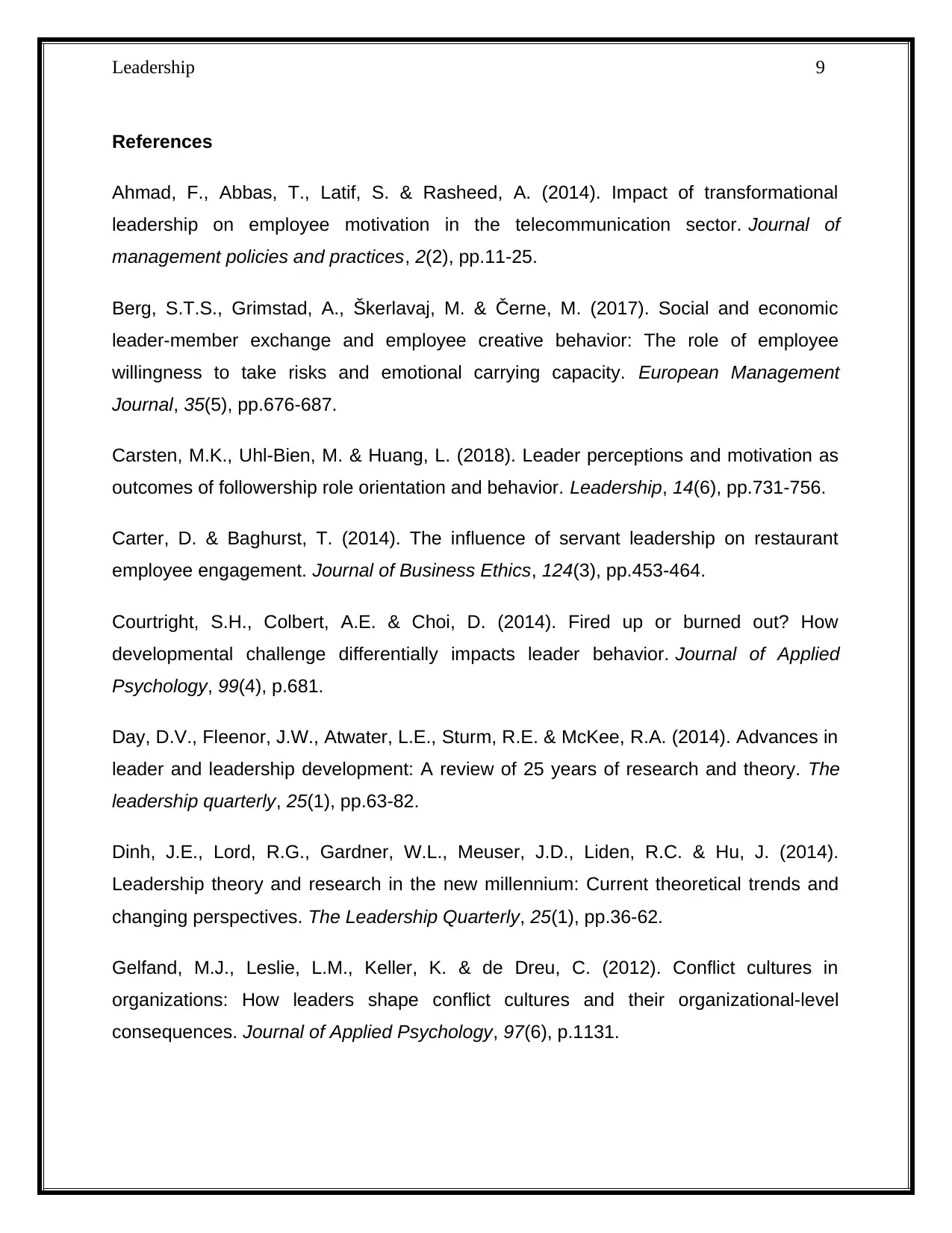
Leadership 9
References
Ahmad, F., Abbas, T., Latif, S. & Rasheed, A. (2014). Impact of transformational
leadership on employee motivation in the telecommunication sector. Journal of
management policies and practices, 2(2), pp.11-25.
Berg, S.T.S., Grimstad, A., Škerlavaj, M. & Černe, M. (2017). Social and economic
leader-member exchange and employee creative behavior: The role of employee
willingness to take risks and emotional carrying capacity. European Management
Journal, 35(5), pp.676-687.
Carsten, M.K., Uhl-Bien, M. & Huang, L. (2018). Leader perceptions and motivation as
outcomes of followership role orientation and behavior. Leadership, 14(6), pp.731-756.
Carter, D. & Baghurst, T. (2014). The influence of servant leadership on restaurant
employee engagement. Journal of Business Ethics, 124(3), pp.453-464.
Courtright, S.H., Colbert, A.E. & Choi, D. (2014). Fired up or burned out? How
developmental challenge differentially impacts leader behavior. Journal of Applied
Psychology, 99(4), p.681.
Day, D.V., Fleenor, J.W., Atwater, L.E., Sturm, R.E. & McKee, R.A. (2014). Advances in
leader and leadership development: A review of 25 years of research and theory. The
leadership quarterly, 25(1), pp.63-82.
Dinh, J.E., Lord, R.G., Gardner, W.L., Meuser, J.D., Liden, R.C. & Hu, J. (2014).
Leadership theory and research in the new millennium: Current theoretical trends and
changing perspectives. The Leadership Quarterly, 25(1), pp.36-62.
Gelfand, M.J., Leslie, L.M., Keller, K. & de Dreu, C. (2012). Conflict cultures in
organizations: How leaders shape conflict cultures and their organizational-level
consequences. Journal of Applied Psychology, 97(6), p.1131.
References
Ahmad, F., Abbas, T., Latif, S. & Rasheed, A. (2014). Impact of transformational
leadership on employee motivation in the telecommunication sector. Journal of
management policies and practices, 2(2), pp.11-25.
Berg, S.T.S., Grimstad, A., Škerlavaj, M. & Černe, M. (2017). Social and economic
leader-member exchange and employee creative behavior: The role of employee
willingness to take risks and emotional carrying capacity. European Management
Journal, 35(5), pp.676-687.
Carsten, M.K., Uhl-Bien, M. & Huang, L. (2018). Leader perceptions and motivation as
outcomes of followership role orientation and behavior. Leadership, 14(6), pp.731-756.
Carter, D. & Baghurst, T. (2014). The influence of servant leadership on restaurant
employee engagement. Journal of Business Ethics, 124(3), pp.453-464.
Courtright, S.H., Colbert, A.E. & Choi, D. (2014). Fired up or burned out? How
developmental challenge differentially impacts leader behavior. Journal of Applied
Psychology, 99(4), p.681.
Day, D.V., Fleenor, J.W., Atwater, L.E., Sturm, R.E. & McKee, R.A. (2014). Advances in
leader and leadership development: A review of 25 years of research and theory. The
leadership quarterly, 25(1), pp.63-82.
Dinh, J.E., Lord, R.G., Gardner, W.L., Meuser, J.D., Liden, R.C. & Hu, J. (2014).
Leadership theory and research in the new millennium: Current theoretical trends and
changing perspectives. The Leadership Quarterly, 25(1), pp.36-62.
Gelfand, M.J., Leslie, L.M., Keller, K. & de Dreu, C. (2012). Conflict cultures in
organizations: How leaders shape conflict cultures and their organizational-level
consequences. Journal of Applied Psychology, 97(6), p.1131.
⊘ This is a preview!⊘
Do you want full access?
Subscribe today to unlock all pages.

Trusted by 1+ million students worldwide
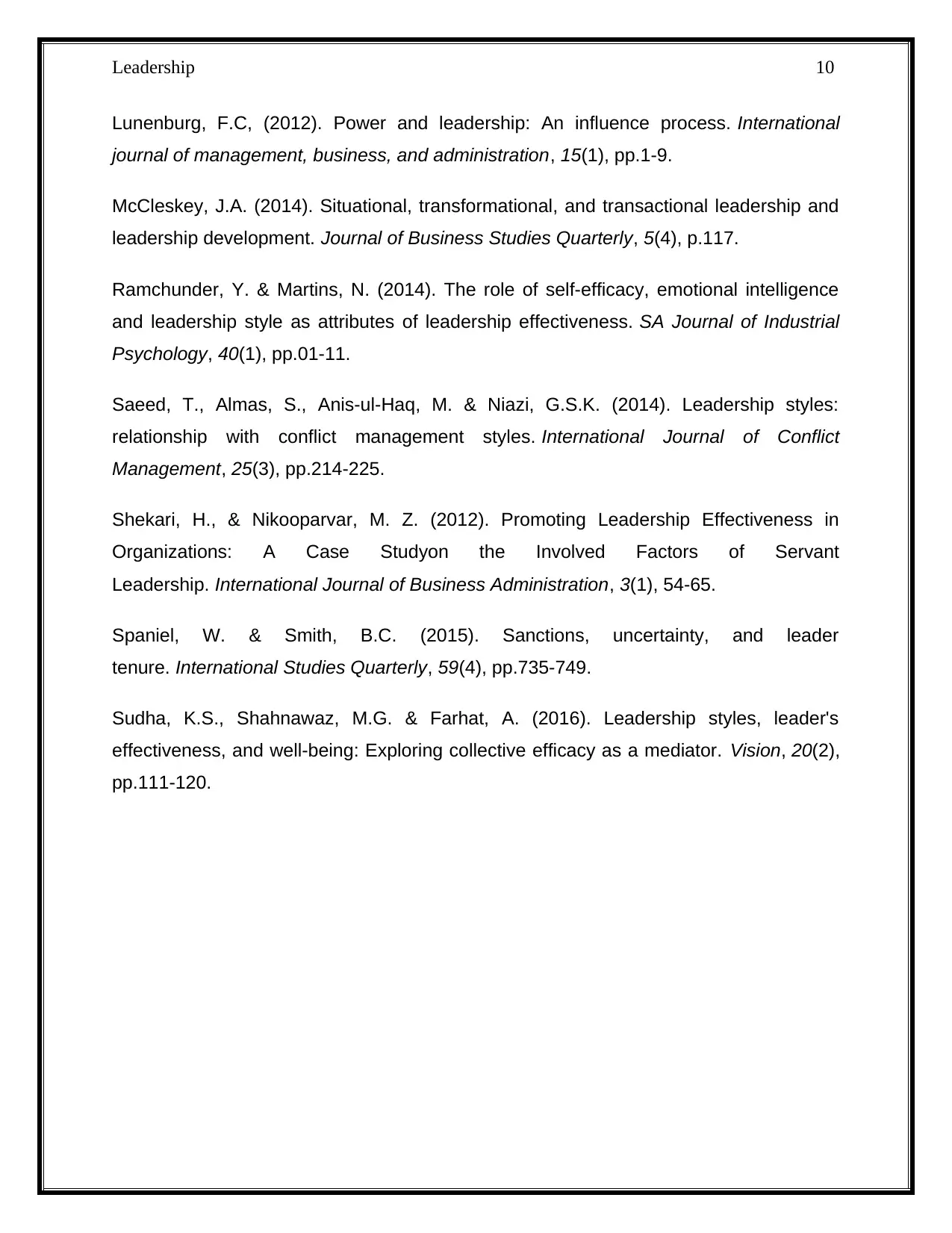
Leadership 10
Lunenburg, F.C, (2012). Power and leadership: An influence process. International
journal of management, business, and administration, 15(1), pp.1-9.
McCleskey, J.A. (2014). Situational, transformational, and transactional leadership and
leadership development. Journal of Business Studies Quarterly, 5(4), p.117.
Ramchunder, Y. & Martins, N. (2014). The role of self-efficacy, emotional intelligence
and leadership style as attributes of leadership effectiveness. SA Journal of Industrial
Psychology, 40(1), pp.01-11.
Saeed, T., Almas, S., Anis-ul-Haq, M. & Niazi, G.S.K. (2014). Leadership styles:
relationship with conflict management styles. International Journal of Conflict
Management, 25(3), pp.214-225.
Shekari, H., & Nikooparvar, M. Z. (2012). Promoting Leadership Effectiveness in
Organizations: A Case Studyon the Involved Factors of Servant
Leadership. International Journal of Business Administration, 3(1), 54-65.
Spaniel, W. & Smith, B.C. (2015). Sanctions, uncertainty, and leader
tenure. International Studies Quarterly, 59(4), pp.735-749.
Sudha, K.S., Shahnawaz, M.G. & Farhat, A. (2016). Leadership styles, leader's
effectiveness, and well-being: Exploring collective efficacy as a mediator. Vision, 20(2),
pp.111-120.
Lunenburg, F.C, (2012). Power and leadership: An influence process. International
journal of management, business, and administration, 15(1), pp.1-9.
McCleskey, J.A. (2014). Situational, transformational, and transactional leadership and
leadership development. Journal of Business Studies Quarterly, 5(4), p.117.
Ramchunder, Y. & Martins, N. (2014). The role of self-efficacy, emotional intelligence
and leadership style as attributes of leadership effectiveness. SA Journal of Industrial
Psychology, 40(1), pp.01-11.
Saeed, T., Almas, S., Anis-ul-Haq, M. & Niazi, G.S.K. (2014). Leadership styles:
relationship with conflict management styles. International Journal of Conflict
Management, 25(3), pp.214-225.
Shekari, H., & Nikooparvar, M. Z. (2012). Promoting Leadership Effectiveness in
Organizations: A Case Studyon the Involved Factors of Servant
Leadership. International Journal of Business Administration, 3(1), 54-65.
Spaniel, W. & Smith, B.C. (2015). Sanctions, uncertainty, and leader
tenure. International Studies Quarterly, 59(4), pp.735-749.
Sudha, K.S., Shahnawaz, M.G. & Farhat, A. (2016). Leadership styles, leader's
effectiveness, and well-being: Exploring collective efficacy as a mediator. Vision, 20(2),
pp.111-120.
1 out of 10
Related Documents
Your All-in-One AI-Powered Toolkit for Academic Success.
+13062052269
info@desklib.com
Available 24*7 on WhatsApp / Email
![[object Object]](/_next/static/media/star-bottom.7253800d.svg)
Unlock your academic potential
Copyright © 2020–2025 A2Z Services. All Rights Reserved. Developed and managed by ZUCOL.





